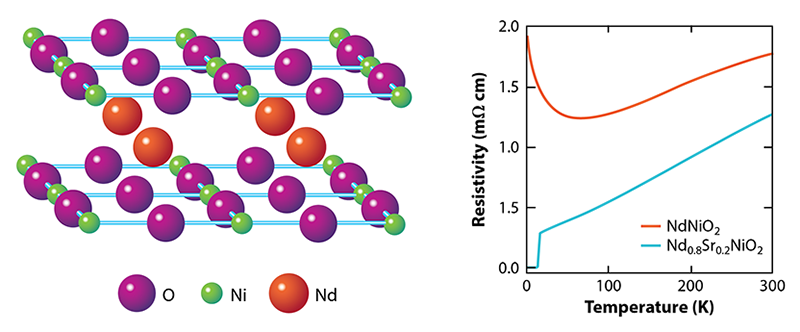Superconducting Nickelates
Literature, University of Naples "Federico II", Department of Physics, 2022-03-30

Three Important ingredients in superconducting cuprates. (see Outlook 2)
- Copper ions $Cu^{-2}$ with $3d^9$ electrons couple strongly to the ligand-oxygen ions, resulting in a strong “electron-lattice” interaction.
- A small “charge-transfer energy” between Cu $3d^9$ electronic state and O $2p$.
- Super-exchange: Indirect interaction between the copper ions, driven by the strong hybridization and small charge-transfer energy. (d-wave)
Extracted from Review [1]
My issues
Why is superconducting nickelates so hot recently?
Nickelate superconductivity has only been reported in thin films so far.
Infinite-layer ?
Experiments
pulsed laser deposition (PLD), Sputtering, molecular beam epitaxy
Magnetic properties?
the undoped $RNiO_2$ compounds did not turn out to be magnetic insulators as the undoped cuprates are. Instead, $RNiO_2$ materials exhibit metallic-like behavior . from Outlook [2].
What is the challenge in experiments
- the simultaneous control of both sample quality and doping necessary to promote superconductivity.
- nickelate superconductivity in a quintuple layer system that is hardly realizable in its bulk form
- the main difficulty lies in the stabilization of the unfavorable high 3+ valence of Ni (instead of its most preferred 2+), reproducibility and off-stoichiometry.
- This difficulty increases for Ca- or Sr-doped films, as required to obtain the subsequent infinite-layer phases in the appropriate regime of Ni 3d-electron filling for superconductivity.
- competition between the perovskite phase and Ruddelsden-Popper phases
- the quality of the samples may be limited by the presence of additional atoms or defects. At the interfaces, in particular, epitaxial strain may favor the presence of oxygen or even A-site vacancies
- Using reducing agent $CaH_2$ thermal annealing stabilizes the oxygen poorer infinite-layer phase. ‘Take out one-third of the oxygen ions using hydrogen as a reducing agent.’ from Outlook [2].
Critical parameters found so far
thicknesses as large as 17 nm (i.e., ~ 50 unit cells), with relatively large critical currents (≳ 200 kA/cm2),
What is the goal of this field?
Single crystal superconductivity
History
1986, George Bednorz and Karl Muller discovered $La_2CuO_4$
1999, Vladimir Anisimov and colleagues suggested $LaNiO_2$ as a strong candidate. But in his assertion: nickel should be $Ni^{1+}$
2019, Hwang’s team found the thin films of strontium-doped $LaNiO_2$ with a $T_c$ of ∼ 10–15 K.
Review
F. Bernardini, L. Iglesias, M. Bibes, and A. Cano, Thin-Film Aspects of Superconducting Nickelates, Front. Phys. 10, 1 (2022).
Norman MR Entering the Nickel Age of Superconductivity. Physics (2020) 13:85. doi:10.1103/physics.13.85 (This outlook is very useful for the ones who want to start this topic)
CrossRef Full Text Google Scholar
Literatures to be viewed
D. Li et al., “Superconductivity in an infinite-layer nickelate,” Nature 572, 624 (2019).
Li D, Lee K, Wang BY, Osada M, Crossley S, Lee HR, et al. Superconductivity in an Infinite-Layer Nickelate. Nature (2019) 572:624–7. doi:10.1038/s41586-019-1496-5 (hole-doped NdNiO2)
| PubMed Abstract | CrossRef Full Text | Google Scholar |
Zeng S, Tang CS, Yin X, Li C, Li M, Huang Z, et al. Phase Diagram and Superconducting Dome of Infinite-Layer Nd1−xSrxNiO2 Thin Films. Phys Rev Lett (2020) 125:147003. doi:10.1103/physrevlett.125.147003
PubMed Abstract CrossRef Full Text Google Scholar Osada M, Wang BY, Goodge BH, Harvey SP, Lee K, Li D, et al. Nickelate Superconductivity without Rare‐Earth Magnetism: (La,Sr)NiO 2. Adv Mater (2021) 33:2104083. doi:10.1002/adma.202104083
CrossRef Full Text Google Scholar Botana AS, Bernardini F, Cano A Nickelate Superconductors: an Ongoing Dialog between Theory and Experiments. Zh Eksp Teor Fiz (2021) 159:711–8. arXiv:2012.02764. doi:10.31857/s0044451021040131
CrossRef Full Text Google Scholar Guo Q, Farokhipoor S, Magén C, Rivadulla F, Noheda B Tunable Resistivity Exponents in the Metallic Phase of Epitaxial Nickelates. Nat Commun (2020) 11:2949. arXiv: 1909.06256. doi:10.1038/s41467-020-16740-5
PubMed Abstract CrossRef Full Text Google Scholar Frano A, Benckiser E, Lu Y, Wu M, Castro-Colin M, Reehuis M, et al. Layer Selective Control of the Lattice Structure in Oxide Superlattices. Adv Mater (2014) 26:258–62. doi:10.1002/adma.201303483 (PLD growth)
PubMed Abstract CrossRef Full Text Google Scholar Scherwitzl R, Zubko P, Lezama IG, Ono S, Morpurgo AF, Catalan G, et al. Electric-Field Control of the Metal-Insulator Transition in Ultrathin NdNiO3 Films. Adv Mater (2010) 22:5517–20. doi:10.1002/adma.201003241 (Sputtering)
PubMed Abstract CrossRef Full Text Google Scholar Mikheev E, Hauser AJ, Himmetoglu B, Moreno NE, Janotti A, Van de Walle CG, et al. Sci Adv (2015) 1:e1500797. doi:10.1126/sciadv.1500797 (Sputtering)
PubMed Abstract CrossRef Full Text King PDC, Wei HI, Nie YF, Uchida M, Adamo C, Zhu S, et al. Atomic-scale Control of Competing Electronic Phases in Ultrathin LaNiO3. Nat Nanotech (2014) 9:443–7. doi:10.1038/nnano.2014.59 (MBE)
| CrossRef Full Text | Google Scholar |
Preziosi D, Sander A, Barthélémy A, Bibes M Reproducibility and Off-Stoichiometry Issues in Nickelate Thin Films Grown by Pulsed Laser Deposition. AIP Adv (2017) 7:015210. doi:10.1063/1.4975307
CrossRef Full Text Google Scholar Gao Q, Zhao Y, Zhou X-J, Zhu Z Preparation of Superconducting Thin Films of Infinite-Layer Nickelate Nd0.8Sr0.2NiO2. Chin Phys. Lett. (2021) 38:077401. doi:10.1088/0256-307x/38/7/077401 (competition between the perovskite phase and Ruddelsden-Popper phases)
CrossRef Full Text Google Scholar
